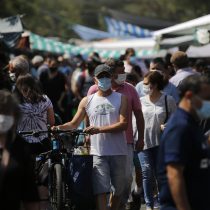
In view of Covid-19’s uptick in contagion figures, the Government of Chile announced amendments to the Paso a Paso Plan, including the suspension of personal travel permits on weekends and public holidays. In this context, Minister Enrique Paris noted that both supermarkets and free fairs should operate on weekends by delivery. Although a subsequent meeting with representatives of the free trade fairs circumscribed for the time being what was noted only at the weekend of 27 and 28 March, Minister Paris’s statements have generated great controversy, being labeled away from reality.
In order to understand the implications of a measure such as the one announced, some key questions need to be considered: what is the general situation of free trade fairs in Chile, how do they contribute to food in cities, how have they evolved in their operation from the beginning of the pandemic to date?
According to figures from the Ministry of Agriculture throughout Chile there are approximately 1,150 free fairs, which are managed by more than 110 thousand locals, generating a total of about 350 thousand direct jobs. Among fairgrounds, the presence of both genders is quite equitable; the majority age range is between 45 and 60 years; and much of the holidays have completed only basic studies. The products that are marketed the most are fruits and vegetables, in many cases from areas relatively close to the fair itself, which encourages local consumption and traditional diets. It is estimated that 70% of the country’s population is supplied with fruits and vegetables through free fairs.
Thus, free fairs are a key channel to bring the production of small domestic agriculture closer to consumers. In fact, small farmers – a majority segment in our country and especially vulnerable – find it very complex to sell in other commercial channels such as supermarkets, let alone export.
In this regard, research published in 2019 showed that supermarkets in Chile offer fresh produce, and in particular fruits and vegetables, at a higher price than free fairs; situation in respect of which there are indications that the pandemic could even have increased it. On the other hand, supermarkets have a tendency to offer lower prices on ultra-processed products (or products with “HIGH EN” stamps) as a result of buying them in large volumes and thereby generating economies of scale. These price differences between unsused and stamped foods are particularly accentuated in lower-income sectors. In these sectors, the prevalence of both overweight and obesity is higher. Because processed supermarket products are cheaper, many families swap free fairs for supermarkets, and tend to incorporate uns nutritious food into their purchases. All this contributes to Chile being one of the countries of Latin America with the highest penetration of supermarkets in the sale of food and with higher levels of consumption of ultra-processed food and beverages.
So how do free fairs contribute to food in cities? According to a 2016 study, 59% of households in the Metropolitan Region have a free fair at a distance of 600 metres or less. However, in lower-income communes these distances are smaller than in high-income communes. This shows that free fairs are suppliers of fresh food, especially in communes where the population has a higher prevalence of malnutrition in all its forms and could therefore benefit even more from the consumption of fresh fruits and vegetables. Especially if obesity and/or chronic nutrition-related diseases such as hypertension and type 2 diabetes are considered to carry an increased risk of morbidity and Covid-19 mortality.
Free fairs also represent a cultural meeting place between neighbors and fairgrounds. Our studies show that the motivations that lead consumers to buy at free fairs are related both to the maintenance of sustainable diets (i.e. low prices, diversity of supply, fresh and high nutritional quality products) and of hedonic type, that is, linked to the experience of the purchase itself. Indeed, a study carried outn fairs in the Metropolitan Region showed that the reliability and kindness of the fairs were particularly valued by buyers.
During the first quarantines, the free fairs of several communes in the Metropolitan Region suspended their operation. For its part, the wholesale market of Lo Valledor and La Vega Central – key points in the transaction of fresh fruits and vegetables nationally – for several months served only traders and individuals who bought for several families. Once mobility restriction measures were softened at the end of August 2020, free fairs resumed and regained closer-than-normal operation. Since then, efforts have been made to train fairs to understand the need to implement higher standards of health protection and be prepared to do so. However, these trainings have not been conducted in a standardized or consistent manner.
With free fairs suspended or with restricted access, many shoppers are likely to look for other vendors to purchase their food, such as supermarkets. Thus, since the beginning of the pandemic, one of the most relevant changes in the business model has been to increase delivery service, both independently and through applications, thereby increasing the “digital food environment”. As most supermarket chains already had experience in this area, they were able to adapt relatively quickly to the largest number of orders caused by pandemic restrictions.
In contrast, most free fairs had no experience in online shopping and/or delivery service. However, the long duration of the pandemic has prompted some free fairs, rather independently, but in some cases with support from institutions, to encourage their insertion into digital sales. For example, the platform “Online Fairs” with online payment and home delivery by the fairs themselves. In addition, some fairs, especially those in the eastern sector of the Metropolitan Region, delivered their products through applications such as Uber Eats during periods of restriction on mobility. For its part, with institutional support, the applications Pedidos Already made an agreement in April 2020 to launch the initiative “Orders Healthy”, including some free fairs of the commune of Santiago in its offer. Independent, more or less formal ventures have also emerged in this same line.
However, the key question is whether, beyond these one-off initiatives, are most fairers trained to sell in a non-face-to-face manner? Studies we have done so far indicate that unfortunately this is not the case. One essential concept that needs to be worked on even more is digital literacy. In this regard, FAO notes that the necessary measures are needed to ensure that actors in food systems are able to take advantage of digital transformation.
Therefore, although the duration of the pandemic has driven some improvements in digital capabilities, the ability of fairers to market their products in a non-face-to-face manner remains significantly lower than other channels, and in some cases not even existing. Consequently, restricting customers’ access to free fairs on weekends without offering additional capabilities to develop and/or improve their digital platforms would have serious consequences for food health. On the one hand, physical and economic access to fruits and vegetables would be reduced; on the other hand, the main channel of already vulnerable small agriculture would be reduced and, finally, the income of traders and workers associated with free trade fairs would be reduced, which would also affect their ability to purchase food for their homes. In this regard, multiple studies show that consumption of fresh produce is even more urgent in times of crisis such as today, as these relate to a stronger immune system.
For this reason, the public effort should focus on improving the conditions of access to free fairs, facilitating and monitoring with much greater intensity compliance with the health requirements in them and, why not, on advancing the ability to make non-face-to-face sales, but with a realistic horizon and avoiding generating greater gaps. More than a year after the advent of the pandemic, stress levels in the face of new restrictions increase, but experience must also allow us to build resilience, i.e. the ability to recover, but with growth that will help us cope with this and the next crises.
The content poured into this opinion column is the sole responsibility of its author, and does not necessarily reflect the editorial line or position of El Mostrador.





